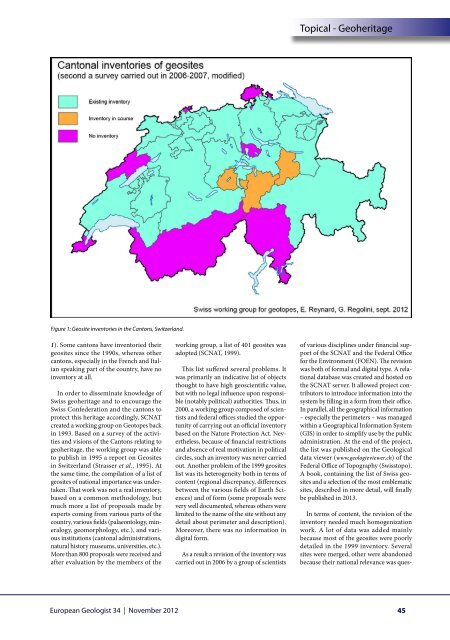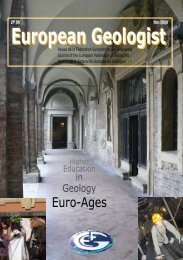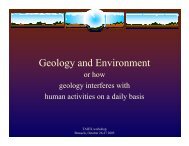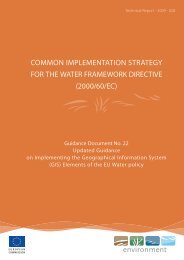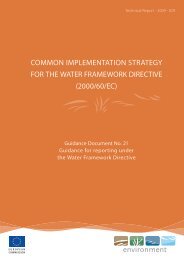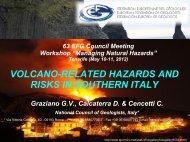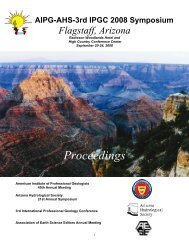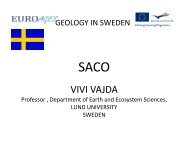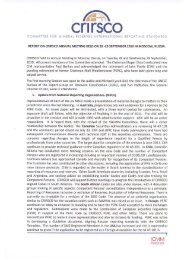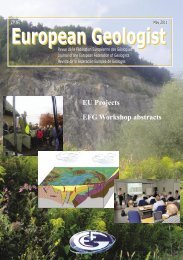European Geologist European Geologist Geoheritage - learning ...
European Geologist European Geologist Geoheritage - learning ...
European Geologist European Geologist Geoheritage - learning ...
Create successful ePaper yourself
Turn your PDF publications into a flip-book with our unique Google optimized e-Paper software.
Topical - <strong>Geoheritage</strong><br />
Figure 1: Geosite inventories in the Cantons, Switzerland.<br />
1). Some cantons have inventoried their<br />
geosites since the 1990s, whereas other<br />
cantons, especially in the French and Italian<br />
speaking part of the country, have no<br />
inventory at all.<br />
In order to disseminate knowledge of<br />
Swiss geoheritage and to encourage the<br />
Swiss Confederation and the cantons to<br />
protect this heritage accordingly, SCNAT<br />
created a working group on Geotopes back<br />
in 1993. Based on a survey of the activities<br />
and visions of the Cantons relating to<br />
geoheritage, the working group was able<br />
to publish in 1995 a report on Geosites<br />
in Switzerland (Strasser et al., 1995). At<br />
the same time, the compilation of a list of<br />
geosites of national importance was undertaken.<br />
That work was not a real inventory,<br />
based on a common methodology, but<br />
much more a list of proposals made by<br />
experts coming from various parts of the<br />
country, various fields (palaeontology, mineralogy,<br />
geomorphology, etc.), and various<br />
institutions (cantonal administrations,<br />
natural history museums, universities, etc.).<br />
More than 800 proposals were received and<br />
after evaluation by the members of the<br />
working group, a list of 401 geosites was<br />
adopted (SCNAT, 1999).<br />
This list suffered several problems. It<br />
was primarily an indicative list of objects<br />
thought to have high geoscientific value,<br />
but with no legal influence upon responsible<br />
(notably political) authorities. Thus, in<br />
2000, a working group composed of scientists<br />
and federal offices studied the opportunity<br />
of carrying out an official inventory<br />
based on the Nature Protection Act. Nevertheless,<br />
because of financial restrictions<br />
and absence of real motivation in political<br />
circles, such an inventory was never carried<br />
out. Another problem of the 1999 geosites<br />
list was its heterogeneity both in terms of<br />
content (regional discrepancy, differences<br />
between the various fields of Earth Sciences)<br />
and of form (some proposals were<br />
very well documented, whereas others were<br />
limited to the name of the site without any<br />
detail about perimeter and description).<br />
Moreover, there was no information in<br />
digital form.<br />
As a result a revision of the inventory was<br />
carried out in 2006 by a group of scientists<br />
of various disciplines under financial support<br />
of the SCNAT and the Federal Office<br />
for the Environment (FOEN). The revision<br />
was both of formal and digital type. A relational<br />
database was created and hosted on<br />
the SCNAT server. It allowed project contributors<br />
to introduce information into the<br />
system by filling in a form from their office.<br />
In parallel, all the geographical information<br />
– especially the perimeters – was managed<br />
within a Geographical Information System<br />
(GIS) in order to simplify use by the public<br />
administration. At the end of the project,<br />
the list was published on the Geological<br />
data viewer (www.geologieviewer.ch) of the<br />
Federal Office of Topography (Swisstopo).<br />
A book, containing the list of Swiss geosites<br />
and a selection of the most emblematic<br />
sites, described in more detail, will finally<br />
be published in 2013.<br />
In terms of content, the revision of the<br />
inventory needed much homogenization<br />
work. A lot of data was added mainly<br />
because most of the geosites were poorly<br />
detailed in the 1999 inventory. Several<br />
sites were merged, other were abandoned<br />
because their national relevance was ques-<br />
<strong>European</strong> <strong>Geologist</strong> 34 | November 2012<br />
45


